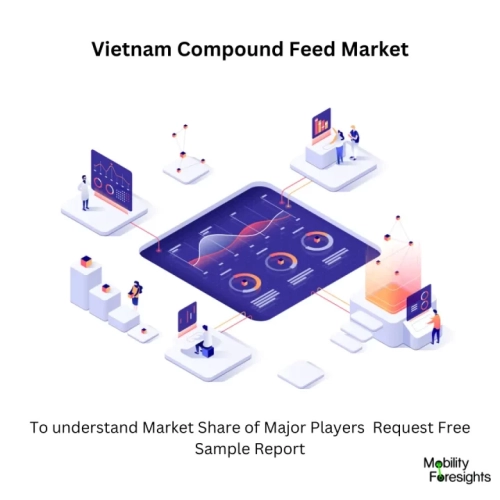
- Get in Touch with Us

Last Updated: Apr 25, 2025 | Study Period:
The Vietnam compound feed market is a crucial segment of the country's agricultural sector, playing a significant role in supporting the livestock industry. As Vietnam continues to develop economically, the demand for high-quality animal protein is on the rise, leading to increased consumption of meat and dairy products. This shift is driving growth in the compound feed market, as producers seek efficient and effective nutrition solutions to meet the needs of livestock.
Vietnam's diverse agricultural landscape allows for a wide range of raw materials to be used in feed production. Key ingredients include corn, soybean meal, and fishmeal, which are essential for formulating nutritionally balanced feeds for various livestock species. The country has made significant strides in improving feed manufacturing processes, resulting in higher quality products that contribute to better livestock health and productivity.
However, the market is not without challenges. Rising feed costs, due in part to global commodity price fluctuations, present significant hurdles for manufacturers. Additionally, the need for compliance with food safety regulations and sustainability practices has led to increased scrutiny of production methods. To thrive in this evolving market, stakeholders must navigate these challenges while continuing to innovate and invest in sustainable practices.
TheVietnam Compound Feed Marketencompasses the production and sale of formulated feeds designed to meet the nutritional requirements of livestock and aquaculture species. As a critical component of the agricultural industry, this market supports the overall growth and productivity of animal farming in Vietnam, which is essential for ensuring food security and meeting the increasing demand for animal protein among consumers.
Different types of compound feed are produced for various livestock species, includingpoultry feed,swine feed,cattle feed, andaquaculture feed. Each type of feed is carefully formulated to provide a balanced diet that enhances growth, reproduction, and overall health. The specific nutritional needs of these animals are addressed through tailored feed formulations that take into account their life stages, production goals, and health requirements.
The benefits of compound feed include improved feed efficiency, enhanced animal growth rates, and better overall health, leading to increased profitability for producers. However, challenges such as rising raw material costs, regulatory compliance, and the need for continuous innovation pose significant hurdles for market participants. Stakeholders must focus on sustainable sourcing and production methods to remain competitive and align with evolving consumer preferences.

| Company Name | Product Description | Analyst View |
| C.P. Vietnam | Launching a new line of high-protein aquaculture feed designed to enhance growth rates and sustainability. | This initiative positions C.P. Vietnam as a leader in sustainable aquaculture practices. |
| Mavin Group | Developing organic poultry feed made from locally sourced ingredients, targeting health-conscious consumers. | The focus on organic products aligns with rising consumer demand for natural and safe food options. |
| Sovico Group | Introducing a new swine feed with added probiotics to improve gut health and reduce antibiotic use. | This product addresses the growing trend toward antibiotic-free livestock production. |
| An Phat Holdings | Launching an innovative range of feed additives that enhance nutrient absorption and overall animal health. | This reflects the industryâs shift towards maximizing feed efficiency and supporting animal welfare. |
| GreenFeed Vietnam | Creating a specialized cattle feed formulated for optimal milk production, incorporating the latest nutritional research. | This product aims to meet the needs of dairy farmers seeking to maximize yield and profitability. |
By Livestock Type:
By Feed Type:
By Ingredients:
By Distribution Channel:
| Sr. No | TOPICS |
| 1 | Market Segmentation |
| 2 | Scope of the Report |
| 3 | Research Methodology |
| 4 | Executive Summary |
| 5 | Introduction |
| 6 | Average B2B Price |
| 7 | Regional Analysis and Trends |
| 8 | Impact of Technological Advancements on the Vietnam Compound Feed Market |
| 9 | Demand Technology Trends in the Industry |
| 10 | Major Key Drivers in the Market |
| 11 | Recent Product Developments |
| 12 | Manufacturing Footprint for Major Players |
| 13 | Recent Orders in the Vietnam Compound Feed Market |
| 14 | Market Dynamics and Strategic Initiatives |
| 15 | Analysis of Vietnam Compound Feed Market Initiatives on Market Growth |
| 16 | Impact of Sustainable Practices on Market Trends |
| 17 | Market Size, Dynamics, and Forecast by Livestock Type, 2024-2030 |
| 18 | Market Size, Dynamics, and Forecast by Feed Type, 2024-2030 |
| 19 | Market Size, Dynamics, and Forecast by Ingredients, 2024-2030 |
| 20 | Market Size, Dynamics, and Forecast by Distribution Channel, 2024-2030 |
| 21 | Pricing Strategies and Market Positioning |
| 22 | Competitive Landscape |
| 23 | M&A in the Past 12 Months |
| 24 | Growth Strategy of Leading Players |
| 25 | Market Share of Vendors, 2024 |
| 26 | Company Profiles |
| 27 | Unmet Needs and Opportunity for New Suppliers |
| 28 | Conclusion |